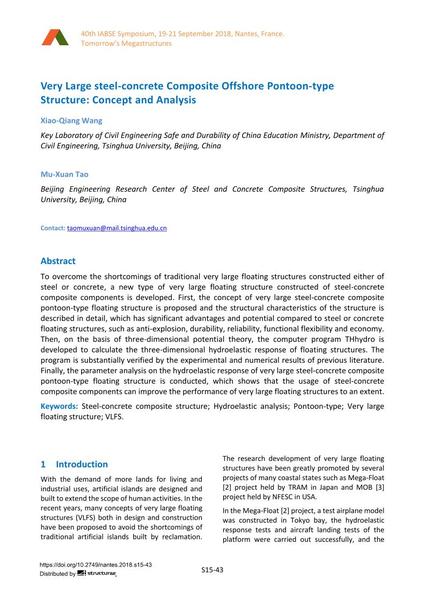Very Large steel-concrete Composite Offshore Pontoon-type Structure: Concept and Analysis

|
|
|||||||||||
Détails bibliographiques
| Auteur(s): |
Xiao-Qiang Wang
(Key Laboratory of Civil Engineering Safe and Durability of China Education Ministry, Department of Civil Engineering, Tsinghua University, Beijing, China)
Mu-Xuan Tao (Beijing Engineering Research Center of Steel and Concrete Composite Structures, Tsinghua University, Beijing, China) |
||||
|---|---|---|---|---|---|
| Médium: | papier de conférence | ||||
| Langue(s): | anglais | ||||
| Conférence: | IABSE Symposium: Tomorrow’s Megastructures, Nantes, France, 19-21 September 2018 | ||||
| Publié dans: | IABSE Symposium Nantes 2018 | ||||
|
|||||
| Page(s): | S15-43 | ||||
| Nombre total de pages (du PDF): | 8 | ||||
| DOI: | 10.2749/nantes.2018.s15-43 | ||||
| Abstrait: |
To overcome the shortcomings of traditional very large floating structures constructed either of steel or concrete, a new type of very large floating structure constructed of steel-concrete composite components is developed. First, the concept of very large steel-concrete composite pontoon-type floating structure is proposed and the structural characteristics of the structure is described in detail, which has significant advantages and potential compared to steel or concrete floating structures, such as anti-explosion, durability, reliability, functional flexibility and economy. Then, on the basis of three-dimensional potential theory, the computer program THhydro is developed to calculate the three-dimensional hydroelastic response of floating structures. The program is substantially verified by the experimental and numerical results of previous literature. Finally, the parameter analysis on the hydroelastic response of very large steel-concrete composite pontoon-type floating structure is conducted, which shows that the usage of steel-concrete composite components can improve the performance of very large floating structures to an extent. |
||||
